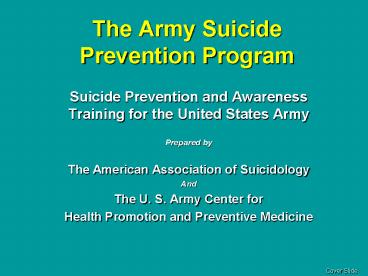The Army Suicide Prevention Program - PowerPoint PPT Presentation
1 / 32
Title:
The Army Suicide Prevention Program
Description:
Describe primary, secondary and tertiary suicide prevention. ... Excessive anger, rage, and hostility. OH 6b, pg 26. Numbers and rates per 100,000 ... – PowerPoint PPT presentation
Number of Views:438
Avg rating:3.0/5.0
Title: The Army Suicide Prevention Program
1
The Army Suicide Prevention Program
- Suicide Prevention and Awareness Training for the
United States Army - Prepared by
- The American Association of Suicidology
- And
- The U. S. Army Center for
- Health Promotion and Preventive Medicine
Cover Slide
2
Enabling Learning Objectives
- Describe primary, secondary and tertiary suicide
prevention. - Identify personal and environmental protective
factors. - Know information about local support resources
and programs.
OH 1 a, pg 7
3
Enabling Learning Objectives
- 4. Promote cohesion and a sense of belonging.
- 5. Destigmatize and encourage help seeking.
OH 1 b, pg 7
4
The Army Suicide Prevention Program
TERTIARY
Recognizing and treating acute suicidal
behavioral
SECONDARY
Recognizing the signs of Crisis and providing
Caring support
PRIMARY
Anticipating peoples potential times of crisis
and structuring pre-emptive support systems
OH 2, pg 8
5
Structure
Secure (Tertiary)
Screen (Primary)
Spot (Secondary)
OH 3, pg 9
6
Personal Protective Factors
- Easy temperament.
- Previous experience with self-mastery, problem
solving, crisis resolution. - Optimistic outlook.
- Social/emotional competence.
- High self esteem, self worth.
OH 4a , pg 9
7
Personal Protective Factors
- Decision making, problem solving skills.
- Sense of personal control, self efficacy.
- Sense of belonging to a group and/or
organization. - High and realistic expectations.
- High spiritual resiliency.
OH 4b, pg 9
8
Environmental Protective Factors
- Strong family relationships.
- Models of healthy coping.
- Encouragement of participation.
- Opportunities to make significant contributions
OH 5 a, pg 9
9
Environmental Protective Factors
- Available social supports.
- Available helping resources.
- Healthy spiritual/religious affiliation.
- Cultural and religious beliefs against suicide
and in support of self-preservation.
OH 5 b, pg 9
10
Connections save lives.
- Spiritual connectedness
- Unit cohesiveness
OH 7, pg 10
11
Seeking help is a sign of effectively dealing
with problems, and of strength rather than
weakness.
OH 8, pg 11
12
A good leader does not expose those under his/her
command to unnecessary risk.
OH 9, pg 11
13
Support
- Promote a norm of mutual support among all
military personnel we are our fellow soldiers
keepers! - Pay attention to warning signs and respond to
those who need help.
OH 10 a, pg 11
14
Support
- Pay close attention to the personal needs of your
people, and be on the lookout for signs of
stress. - Communicate in your words and actions that it is
not only acceptable, but a sign of strength, to
recognize life problems and get help to deal with
them constructively.
OH 10 b, pg 11
15
Support
- Support and protect to the fullest extent
possible those courageous people who seek help
early, before a crisis develops.
OH 10 c, pg 11
16
Support
- Create a responsive, caring, and responsible
community where individuals are motivated to seek
help with personal struggles without fear of
stigmatization.
OH 10 d, pg 11
17
Support
- Foster a social climate in your unit that
communicates to everyone, you belong here.
OH 10 e, pg 11
18
The Problem of Suicide
- Serious suicidal thoughts or threats.
- Self destructive acts
- Attempts to harm, but not kill oneself.
- Attempts to commit suicide.
- Completed suicide.
OH 5, pg 25
19
Categories of Suicide
- Lack of control related to needs for achievement,
order, or understanding. - Problems with self-image related to frustrated
needs for affiliation
OH 6a, pg 26
20
Categories of Suicide
- Problems with key relationships related to grief
and loss in life. - Excessive anger, rage, and hostility.
OH 6b, pg 26
21
Numbers and rates per 100,000 of Suicides in the
Army
OH 7, pg 28
22
Responding to Statements or Threats
- Stay calm.
- Send someone for help.
- Do not leave alone.
- Buy time.
OH 3 a, pg 42
23
Responding to Statements or Threats
- Acknowledge.
- Listen.
- Convey.
OH 3 b, pg 42
24
Responding to Statements or Threats
- Secure.
- Note the time.
- Take action.
OH 3 c, pg 42
25
Asking About Suicide
- Review your evidence.
- Inquire or state about feelings.
- Persist.
- Sometimes approach.
OH 4 a, pg 43
26
Asking About Suicide
- Ask directly.
- Get help.
- Convey concern.
OH 4 b, pg 43
27
The only thing that will save a human life is a
human relationship.
OH 5, pg 47
28
Risk Assessment Questions
- Have you been thinking of killing yourself?
- What has happened that makes life not worth
living? - How will you do it?
OH 3 a, pg 52
29
Risk Assessment Questions
- How much do you want to die?
- How much do you want to live?
- How often do you have these thoughts?
- When you think of suicide, how long do the
thoughts stay with you?
OH 3 b, pg 52
30
Risk Assessment Questions
- Have you ever attempted suicide?
- Have you been drinking heavily lately or taking
drugs? - Has anyone in your family committed or attempted
suicide? - Is there anyone or anything to stop you?
- On a scale of 1 to 10, what is the probability
that you will kill yourself?
OH 3 c, pg 52
31
Assessing the Suicide Plan
- Specificity.
- Method or means.
- Availability accessibility of means.
OH 6, pg 59
32
T Thoughts I Intent P Plan M Means
OH 7, pg 60































